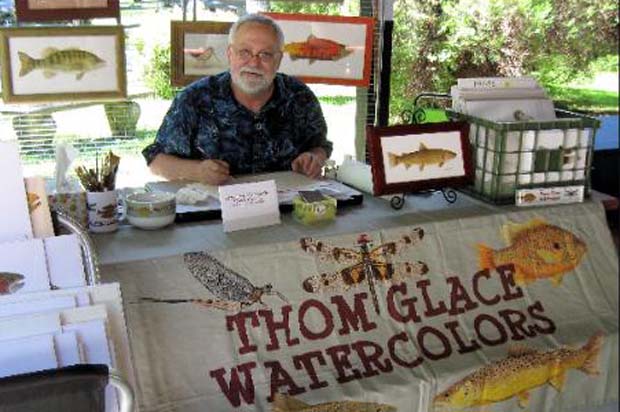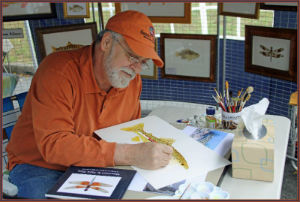 Thom Glace volunteers both his time and art to many causes. Serendipitously, that got him introduced to the art of Tenkara.
Thom Glace volunteers both his time and art to many causes. Serendipitously, that got him introduced to the art of Tenkara.
[dropcap]T[/dropcap]hom Glace is a world renown watercolor artist. His accolades too many to list here. He also happens to be a friend and a fellow University of North Carolina alum.
A while back, Thom started complaining about having locomotion difficulties, a disability that would eventually sideline him from fly fishing.
Glace is not a fly fishing celebrity nor is he tied to the fly fishing industry and as such not prone to protect his angling comments. We asked Thom about Tenkara, and here is what he had to say
Fly Life Magazine.com: When did you get introduced to Tenkara fly fishing? And what motivated you to try it?
Thom Glace: Four Years ago, while researching the Amago Trout and Masu Salmon of Japan for paintings, I contacted Jeff Gottfried of Portland Oregon. He runs a non-profit called Educational Recreational Adventures that introduces kids to nature and educates them through outdoors activities. It’s a very successful program.
Our Facebook connection had to do with those trout I was painting. Jeff, I knew, had been to Japan and was versed in the ancient and revered way of Tenkara. He told me he had become a qualified Tenkara Instructor while in Japan. It piqued my interest.
Throughout our discussing the Amago, he coaxed me into the whole Tenkara concept – encouraging me to restart my fly fishing engine. It did sound like a way for me to get back on the water and fly fish again. As advertised by Jeff, I quickly realized the Tenkara style of fishing did not require the physical aspects of conventional fly fishing that had forced me off the water.
I am so very thankful to Jeff for nudging me over the cliff. I now enjoy very productive outings on my home waters in Pennsylvania.
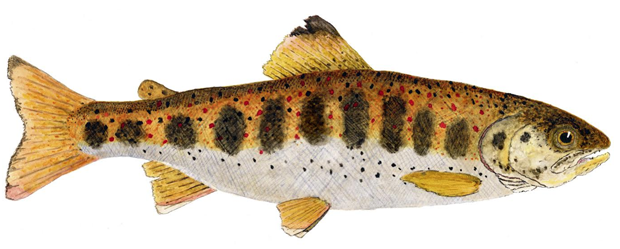
Amago trout.
FLM: Other than physical benefits, what are the actual benefits of Tenkara fly fishing?
TG: Low cost for both gear and upkeep (around $200 for everything – no reel needed), ease of setup and lack of need for all the miscellaneous equipment that fly fishing seems to generate. All you need is a rod that reduces down to less than two feet, line, leader, and two or three Kebari reverse hackle flies – net optional.
As for the fishing part, nymphing especially, Tenkara is at its best. It does not matter how good an angler you are when you attempt to fish a still piece of water in a flowing water situation. Your line will snake up in seconds when laid across conflicting currents, and no respectable trout will feed. With Tenkara, I fish that same piece of still water without any flow threat to my fly or presentation. My fly line never touches the water – just the fly.
I fish the Appalachian Trail and Tenkara fishing is made for those waters. Too, with a Tenkara set up, I am not loaded down with gear. The Tenkara and accouterments that make up the system can all fit in my school-kid sized backpack or even my back pocket and vest if need be.
It is great for people with physical handicaps – missing an arm, leg, or having to use a cane or walker, etc.
It is designed for streams and creeks, but not for big raging rivers like those found out west, or ocean surf. Due of course to the limited line length.
FLM: What species do you fish for using Tenkara?
TG: Trout, trout, and more trout! I fish for rainbow, brookies, brown and golden (Palomino) rainbow trout. All found in the limestone fed streams of central Pennsylvania: Yellow Breeches, LeTort, Big Springs – all about 20 minutes from my house!
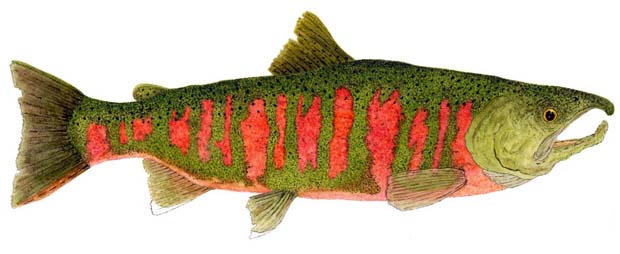
Masu salmon.
FLM: Tell us one of your favorite fishing stories?
TG: I was trying out a new cane that had a fold out seat – it was made for watching Cricket and Polo matches. On a particularly hot day, I was sitting waderless in the middle of the Yellow Breeches in Boiling Springs, Pennsylvania – just cooling off. While I was talking to my fishing partner upstream from me, and not paying attention, my rear dangling and bobbing Kebari fly caught the biggest trout of the day – a 20-inch rainbow. He bought the beer that afternoon.
FLM: Has Tenkara influenced your art perspectives?
TG: Yes! It has me back in the environment of the trout. Nothing is better than seeing and touching the real thing.
One thing in particular – I now am painting the mayflies and stoneflies with caddis fly to come. I was already painting dragonflies, but getting out in the streams greatly expanded my subjects.
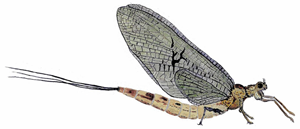 FLM: What is your upcoming schedule?
FLM: What is your upcoming schedule?
TG: I was fortunate to be booked solid with exhibits and shows from January 3 through June of 2017. I have slowed down and am doing commission works. In October, I will be at the Little Buffalo Art Festival in Newport, Pennsylvania and I will be a sponsor at the Cape Lookout Albacore Festival in North Carolina. It is a fundraiser for Project: Healing Waters. I am still deciding on my Christmas shows.
You can follow Thom’s schedule here . . .
NOTE: Thom Glace is currently featured in the 2016 issue of Tenkara USA’s Magazine. It highlights Thom’s Amago trout.
[information]
Thom Glace
208 Melbourne Lane
Mechanicsburg, PA 17055
717.795.4134
thomglace@comcast.net
[/information]


